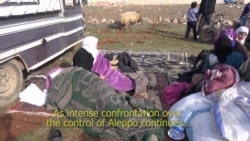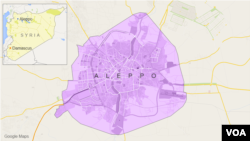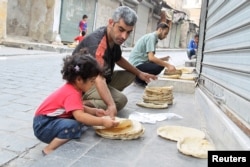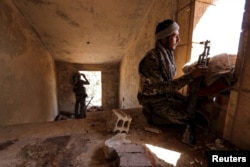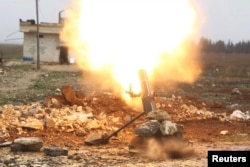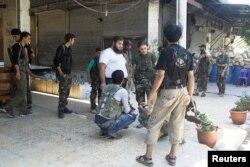Rebels in Aleppo are laying plans to withstand a siege by Syrian President Bashar al-Assad’s forces in the likelihood the regime cuts a final main supply line running west of the city. They vow a siege will not be over quickly. But their plans are not being helped by squabbles breaking out among insurgent commanders.
As forces loyal to President Bashar al-Assad tighten the noose on the rebels in northern Syria, rebel commanders and opposition politicians are scrambling to plan for a prolonged siege of the insurgent-held districts of the city of Aleppo. And they are coming up with contingencies for food, medical supplies as well as ammunition and arms.
They believe the portion of Aleppo they control now can emulate the old city of Homs, which withstood an Assad siege for nearly three years.
The rebel-held area of Aleppo will be a much bigger challenge for the regime to starve or bomb into submission, says Mazen Gharibah of the Local Administration Councils Unit, part of the Western-backed rebel Syrian Interim Government.
Aleppo's needs immense
“The difference is huge between Homs and Aleppo,” says Gharibah. “First of all in Homs, the area that was besieged was very small in comparison to Aleppo. In Homs we had 5,000 civilians besieged in a very small restricted area. In Aleppo we have more than 250,000 in a very vast area, Aleppo is one of the largest cities in Syria,” he says.
He points out that the insurgent areas of Aleppo have a strong infrastructure of NGOs and pro-opposition local governance. There are more than 120 NGOs working in the city and in recent months opposition civilian authorities and the armed militias have been working well together, he says.
Rebel commanders and opposition activists are planning to use tunnels to re-supply the city’s insurgent areas. And they say that even if the regime manages, which most expect it will in the coming days, to cut the small supply corridor remaining west of Aleppo, there are still smaller roads they can use to get some food and medical supplies and arms into the city.
This week, the U.N.’s Office for the Coordination of Humanitarian Affairs (OHCA) instructed international relief agencies it partners with to reposition as best they can food stores closer to the city and to move what they can inside. OHCA is updating plans it started drafting a year ago for an Aleppo siege, say European diplomats.
International aid crucial
U.N. and U.S. officials have warned of a potential “humanitarian disaster” in the event Aleppo is besieged by Russian-backed Assad regime forces. And in U.S.-led international coalition talks in Munich Thursday a humanitarian corridor for a besieged Aleppo will be at the top of the agenda, say U.S. officials.
“There have been several meetings between local NGOs and local councils and international NGOs as well both in Gaziantep and inside of Aleppo in order to have an emergency plan, a response plan for Aleppo,” says Gharibah.
Included in the plan is the setting up of a trust fund for Aleppo, which opposition politicians hope foreign governments and ordinary people around will contribute to as the siege unfolds.
But the planning — especially when it comes to grain and food-stocks — is being made harder by the intensity of the fighting and bombing, the sheer force of the Russian-backed offensive and the risk of plunder and looting by militias, including the Kurdish People’s Protection Units, or YPG.
Regime not the only enemy
Earlier this week, the YPG stole 460 out of 500 tons of wheat from a rebel store at a village north of Aleppo.
“We are doing now a whole strategy, and one of the strategies is to move some wheat inside Aleppo, at least 1,000 tons,” says Moayyad Yousef of the Assistance Coordination Unit (ACU), which was established in 2012 by the main political opposition group, the Syrian Coalition, to distribute aid.
But that only will be enough wheat for just one month.
The ACU is also moving wheat and food around northern Syria to try to keep the stores safe.
“We are trying to find somewhere close to the border of Turkey but still we can’t find anywhere until now. You can’t figure out where it is going to be safe, you can’t, it is hard,” Yousef told VOA.
Opposition politicians say they are harboring hopes that Saudi Arabia will send medical supplies. In 2014, the Saudis sent $17 billion of medical supplies. “That was fantastic and we need them to do that again. We need everything. We need food,” says ACU’s Yousef.
Siege expected with or without cease-fire
According to Osama Taljo, one of 25 members of the city council for the rebel-held area of Aleppo, it would take at least a year for the siege to force a surrender. “We are trying to provide what will be needed to ensure the city can withstand a siege for at least a year,” he says. “And I hope longer,” he added.
Unlike Homs and Ghouta, a suburb of Damascus that was under siege for two years, Aleppo has had time to prepare. He insists the morale of civilians in the rebel-held portion of the city is high — and so too their determination.
“They have been used to all kinds of killing and all kinds of weapons and they have remained steady,” he says. He dismissed Russian offers of a cease-fire — made in Munich Wednesday. “Whatever happens in Munich, Aleppo will be besieged,” he said.
Rebel commanders argue that the prospects for holding out for years are good. They point out that any siege imposed on Aleppo by the regime will have gaps in it and won’t be uniform — because some areas around the city will be controlled by the Islamic State and the YPG.
“Daesh will still want to trade oil,” says a rebel commander, using the Arab acronym for the Islamic State.
Lack of cooperation a worry
But General Salem Idris, former FSA chief of staff, is worried. He still advises some of the militias on military tactics and says there is not enough coordination going on.
“I am sorry to tell you that until now that is a problem,” he told VOA. “There is no central command for Aleppo even now. There are many attempts now to have what is called a military operations center for the northern suburbs of Aleppo. I don’t know if they understand what will happen in the coming days. In a meeting to have a tactical plan there were differences between them about who will control the border crossing at Bab al-Salameh, if they succeed.”
Idris fumes: “They may lose everything and they still think about personal interests.”




